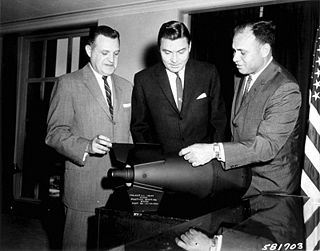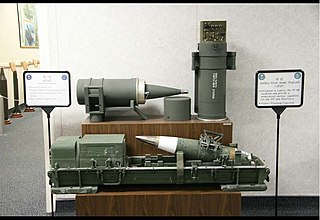Related Research Articles

Operation Nougat was a series of 44 nuclear tests conducted at the Nevada Test Site in 1961 and 1962, immediately after the Soviet Union abrogated a testing moratorium, with the US' Mink test shot taking place the day before the Soviets test-detonated the Tsar Bomba. Most tests were limited-yield underground test shots. New designs would be further developed in atmospheric testing during Operation Dominic I and II.

The B-41 was a thermonuclear weapon deployed by the United States Strategic Air Command in the early 1960s. It was the most powerful nuclear bomb ever developed by the United States, with a maximum yield of 25 megatons of TNT. A top secret document, states “The US has stockpiled bombs of 9 MT and 23 MT...” which would likely be referring to the B-41's actual yield(s). The B-41 was the only three-stage thermonuclear weapon fielded by the U.S.

The W54 was a tactical nuclear warhead developed by the United States in the late 1950s. The weapon is notable for being the smallest nuclear weapon in both weight and yield to have entered US service. It was a compact implosion device containing plutonium-239 as its fissile material, and in its various versions and mods it had a yield of 10 to 1,000 tons of TNT.

The W50 was an American thermonuclear warhead deployed on the MGM-31 Pershing theater ballistic missile. Initially developed for the LIM-49 Nike Zeus anti-ballistic missile, this application was cancelled before deployment. The W50 was developed by Los Alamos National Laboratory. The W50 was manufactured from 1963 through 1965, with a total of 280 being produced. They were retired from service starting in 1973 with the last units retired in 1991.
The B46 nuclear bomb was an American high-yield thermonuclear bomb which was designed and tested in the late 1950s. It was never deployed. Though originally intended to be a production design, the B46 ended up being only an intermediate prototype of the B-53 and was test fired several times. These prototypes were known as TX-46 units (Test/Experimental).

The W79 Artillery-Fired Atomic Projectile (AFAP), also known as XM753 (Atomic RA), was an American nuclear artillery shell, capable of being fired from any NATO 8 in (203 mm) howitzer e.g. the M115 and M110 howitzer. The weapon was produced in two models; the enhanced radiation (ERW) W79 Mod 0 and fission-only W79 Mod 1. Both were plutonium-based linear-implosion nuclear weapons.

The W58 was an American thermonuclear warhead used on the Polaris A-3 submarine-launched ballistic missile. Three W58 warheads were fitted as multiple warheads on each Polaris A-3 missile.
The W67 was an American thermonuclear warhead developed from June 1966 but then cancelled prior to any production or service use approximately 18 months later.
The W38 was an American thermonuclear warhead used in the early to mid-1960s as a warhead for Atlas E and F, and LGM-25 Titan I ICBMs. It was first built in 1961 and was in service from 1961 to 1965. 70 were deployed on Titan I missiles and 110 on Atlas missiles. It used the Avco Mark 4 reentry vehicle.
Kinglet was a boosted fission primary used in several American thermonuclear weapons.

The UUM-44 SUBROC was a type of submarine-launched rocket deployed by the United States Navy as an anti-submarine weapon. It carried a 250 kiloton thermonuclear warhead configured as a nuclear depth bomb.
The Mark 22 nuclear bomb (Mk-22) was the first thermonuclear device test by the University of California Radiation Lab (UCRL). The test was part of the Koon shot of Operation Castle. The Mk-22 failed to achieve anything like its intended yield due to premature heating of the secondary from exposure to neutrons. As the other UCRL test planned for the Castle series, the liquid-fueled "Ramrod" device had the same basic design flaw, that test was canceled. Within a month of the bomb's failure, the Mk-22 was terminated because the United States Atomic Energy Commission realized there was nothing that could be done to salvage the design.

The W74 warhead, also known as XM517, was an American nuclear artillery shell that was cancelled before production.

The W82 was a low-yield tactical nuclear warhead developed by the United States and designed to be used in a 155 mm artillery shell. It was conceived as a more flexible replacement for the W48, the previous generation of 155 mm nuclear artillery shell. A previous attempt to replace the W48 with the W74 munition was canceled due to cost.

The W42 was an American nuclear fission weapon developed in 1957.
The W60 was nuclear warhead developed for the United States Navy's long range Typhon LR surface-to-air missile.
The W63 was the Lawrence Livermore Laboratory's entry into a brief competition between Livermore and Los Alamos to design a warhead for the Army's Lance tactical surface to surface missile.
The W64 nuclear warhead was the Los Alamos Laboratory's entry into a brief competition between Lawrence Livermore Laboratory and Los Alamos to design an "enhanced-radiation" nuclear warhead for the United States Army's MGM-52 Lance tactical surface-to-surface missile. In July 1964, both Livermore Labs and Los Alamos started developing competing warheads for the Lance. The Los Alamos design, the W64, was canceled in September 1964 in favor of Livermore's W63. In November 1966, the W63 was canceled in favor of the W70, the model that finally entered production.

Operation Dominic was a series of 31 nuclear test explosions ("shots") with a 38.1 Mt (159 PJ) total yield conducted in 1962 by the United States in the Pacific. This test series was scheduled quickly, in order to respond in kind to the Soviet resumption of testing after the tacit 1958–1961 test moratorium. Most of these shots were conducted with free fall bombs dropped from B-52 bomber aircraft. Twenty of these shots were to test new weapons designs; six to test weapons effects; and several shots to confirm the reliability of existing weapons. The Thor missile was also used to lift warheads into near-space to conduct high-altitude nuclear explosion tests; these shots were collectively called Operation Fishbowl.
The Starling was a small American nuclear bomb developed in the 1950s that was used as the primary in several US thermonuclear weapons.
References
- ↑ Chuck Hansen (2007). Swords of Armageddon. Vol. V. p. 536-540. ISBN 978-0-9791915-5-8.
- ↑ Chuck Hansen (2007). Swords of Armageddon. Vol. VII. p. 220-221. ISBN 978-0-9791915-7-2.
- ↑ History of the Mark 55 Warhead (Report). Sandia National Labs., Albuquerque, NM (USA). January 1968.
- ↑ Carey Sublette. "List of All U.S. Nuclear Weapons". Nuclear Weapon Archive. Retrieved 2022-06-24.
- ↑ "Armaments & Innovations - The Pocket Polaris". U.S. Naval Institute. 2015-08-10. Retrieved 2024-06-09.
- ↑ Jim McConnell; Harry Waugh (1996-12-06). Pantex Plant Activity Report for Week Ending December 6, 1996 (PDF) (Report). Defense Nuclear Facilities Safety Board. Retrieved 2024-06-27.